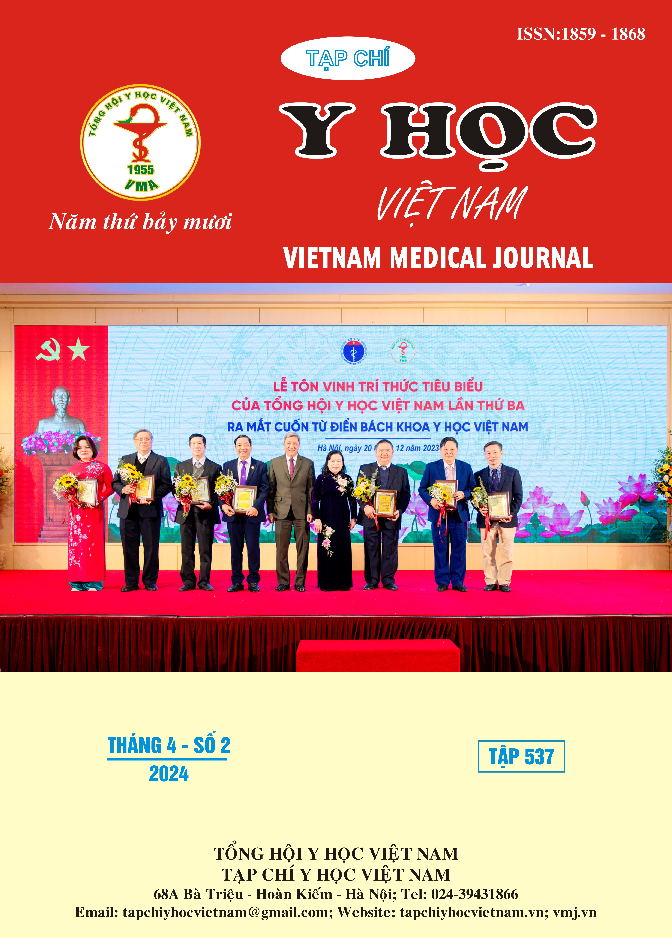BIOCHEMICAL CHANGES IN DENGUE HEMORRHAGIC FEVER CHILDREN ON CRRT
Main Article Content
Abstract
Objectives: The pathogenesis of multi-organ damage in severe dengue is still unclear and may be multifactorial. In the treatment of multi-organ damage, continuous dialysis has become more well known in the past 20 years. This study characterizes biochemical changes in dengue hemorrhagic fever children undergoing continuous hemodialysis. Materials and methods: descriptive 40 children with severe dengue fever received continuous dialysis at the Intensive Care Unit - Anti-poison, Children's Hospital 1 and the Department of Infection, Children's Hospital 2 from January 1, 2017 to December 31, 2021. Results: Before dialysis: recorded 90% of patients with severe liver damage (liver enzyme values > 1000UI/l); the median value of AST was 6339,5 (2873,8 – 11155,8) UI/l and ALT was 1162,7 (614,8 – 2440,8) UI/l; 77,5% of patients progressed to liver failure; The median total and direct bilirubin was 54,8 (25,7 – 84,9) µmol/l and 30,1 (17,3 – 48,6) µmol/l, respectively; NH3 blood recorded a median value of 116,5 (61,2 – 156,.0) µmol/l; median blood albumin was 2,4 (1,7 – 2,9) g/dl; 67,5% of patients had acute kidney injury according to pRIFLE criteria; The median creatinine concentration was 179,5 (88,5 – 244,4) mol/l, in which there were 42,5% cases of dysfunctional lesions (Failure), 17,5% cases of lesions (Injury) and 7,5% risk cases (Risk); The median blood lactate was 7,0 (3,6 – 10,5) mmol/l, of which 100% had increased blood lactate; hyponatremia is the most common, followed by hypocalcaemia and hypokalemia, the mean values of sodium, potassium, and blood calcium are 136,8 ± 7,0 mmol/l, respectively; 3,9 ± 0,7 mmol/l; 1,1 ± 0,2 mmol/l; blood gas test: average pH 7,33 ± 0,11; HCO3- mean 15,6 ± 5,0 mmol/l, median BE -9,8 (-14,0 - -5,5). For blood oxygenation and gas exchange, the median PaO2/FiO2 value was 172,2 (118,1 – 305,3), the median AaDO2 was 390,3 (246,0 – 521,4), The average PaCO2 is 44,0 ± 6,3. After dialysis: liver enzymes, bilirubin, blood lactate, electrolytes, pH, PaO2/FiO2, AaDO2 did not change in the first 24 hours of dialysis; Blood NH3, HCO3-, blood urea and blood creatinine improved at 6 and 24 hours compared with pre-dialysis. Conclusions: Most patients with severe dengue receiving dialysis have severe liver damage and kidney damage. The most common electrolyte disturbances are hyponatremia, hypokalemia, and hypocalcemia. Other biochemical changes are hypoalbuminemia, hyperbilirubinemia, hyperlactatemia, and metabolic acidosis. Tests NH3, urea, creatinine, HCO3- improved during the first 24 hours of continuous dialysis.
Article Details
Keywords
dengue hemorrhagic fever, CRRT.
References
2. Nguyễn Đình Qui (2015), "Đặc điểm rối loạn chức năng các cơ quan ở trẻ sốt xuất huyết dengue nặng tại Khoa Nhiễm - Bệnh viện Nhi Đồng 2 từ 01/2013 đến tháng 12/2015", [Luận văn Thạc sĩ Y học].
3. Nguyễn Hà Giang (2018), "Tổn thương thận cấp ở bệnh nhi sốt xuất huyết dengue", [Luận văn Thạc sĩ Y học].
4. Nguyễn Minh Tiến (2017), "Khảo sát thay đổi albumin máu và mối liên quan với tổn thương các cơ quan của trẻ sốc sốt xuất huyết dengue kéo dài tại Khoa hồi sức tích cực chống độc Bệnh viện Nhi Đồng 1", Tạp chí Y Học Thành Phố Hồ Chí Minh, 21(4),79-89.
5. Nguyễn Minh Tiến, Phạm Văn Quang, Phùng Nguyễn Thế Nguyên, và cộng sự (2016), "Kết quả lọc máu liên tục trong điều trị sốc sốt xuất huyết dengue biến chứng suy đa cơ quan tại Khoa Hồi sức tích cực - chống độc Bệnh viện Nhi Đồng 1 từ năm 2004-2016", Tạp chí Y Học Thành Phố Hồ Chí Minh, 20(4),7-15.
6. Nguyễn Tô Bảo Toàn (2019), "Đặc điểm tổn thương các cơ quan và điều trị sốt xuất huyết dengue nặng có sốc tại Khoa Hồi sức tích cực chống độc Bệnh viện Nhi Đồng 1 từ 7/2018 đến 6/2019", [Luận văn tốt nghiệp chuyên khoa 2].
7. Phùng Nguyễn Thế Nguyên. Theo dõi huyết động trong điều trị sốc nhiễm khuẩn. Sốc nhiễm khuẩn ở trẻ em: Nhà xuất bản Y Học; 2013. p. 153-70.
8. K. Laoprasopwattana, P. Pruekprasert, P. Dissaneewate, A. Geater, P. Vachvanichsanong (2010), "Outcome of dengue hemorrhagic fever-caused acute kidney injury in Thai children", J Pediatr, 157(2),303-9.


